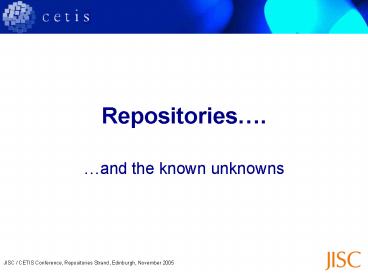Repositories' - PowerPoint PPT Presentation
Title:
Repositories'
Description:
Emerging from that typology identify common repository services and ... Identify what kind of services these repositories will offer ... just reinvent the OAIS ... – PowerPoint PPT presentation
Number of Views:49
Avg rating:3.0/5.0
Title: Repositories'
1
Repositories.
- and the known unknowns
2
Setting the scene
- Reference models, why bother?
- - Bill Olivier
3
Key tasks
- Construct typology / ecology of repositories.
- Emerging from that typology identify common
repository services and distinguish these from
domain specific services. - Identify what kind of services these repositories
will offer and consume.
4
Current practice
- Many existing software platforms for
repositories - with widespread deployment.
- Not developing software systems from scratch.
- eFramework needs to relate to current practice.
- Reference models must accommodate existing
systems.
5
Repositories in other activities
- Repository issues arise in other strands e.g.
- Item banks in assessment
- ePortfolios as repository
- document management for course validation
- ...
- Repository reference models will overlap with
other reference models.
6
Levels of abstraction
- Reference models may exist at different levels.
- May be high level communicative tools e.g.
ontologies. - Or low level specifications e.g. SCORM.
- Acknowledged this but no further discussion.
7
Difficult issues
- End users are joining up networked and desktop
services to suit their own requirements. - Personalisation is becoming a reality.
- Services may be activated at multiple points in a
workflow. - How does this relate to repository typology /
ecology? Not clear.
8
Representation
- Use of UML for gathering requirements usecases is
questionable. - Not trying to build monolithic software
applications. - Aim is not to develop software but identify
services. - If reference models are communication tools other
forms of representation more appropriate e.g.
mind maps. - Some way away from these issues.
9
Some consensus
- DLF approach appears to be as useful as any
other. - Inclusive definition of repository.
- A little dissent
- Is a database a repository?
- Managed and trusted part of Rachels definition.
- Struggling to see functional difference between
national LO repository, item bank community
image store. - Is such inclusive definition of repository
useful?
10
A comparison of repository types
- A national LO repository, e.g. JORUM.
- An assessment item bank.
- A community image store, e.g. Flickr.
- All use similar abstract services
- But the way these services are instantiated
varies enormously - As do the rules and policies associated with
these repositories.
11
Rules and policies
- How do rules and policies relate to reference
models? - In the way they influence the instantiation of
abstract services. - Each rule or policy e.g. student access rights,
must have one of more abstract service associated
with it, e.g. authentication, authorisation.
12
Reference Models Why Bother
- Communication tool
- between domains
- new developers, repository implementers
- Evolve to reflect practice, not necessarily to
drive it. - Gap analysis
13
The danger
- Dont need to retrofit a reference model to what
we already know. - Is it constructive to focus purely on the
abstract? - Focusing too much on reference models may
distract us from real problems that need to be
solved. - We may just reinvent the OAIS model.
14
The unknown
- As we know,
- There are known knowns.
- There are things we know we know.
- We also know
- There are known unknowns.
- That is to say
- We know there are some things
- We do not know.
- But there are also unknown unknowns,
- The ones we don't know
- We don't know.
- - The Rumsfeld approach to reference models
15
For example
- We dont know what kind of API we need to deposit
into repositories. - Flickr and Fedora have published APIs that anyone
can write to. - Can not do the same thing for Dspace or ePrints
for example.
16
The solution?
- Use OAIS as our high level repository reference
model. - Use this as a communication tool across domains.
- And to help identify problem areas - the known
unknowns.
17
The known unknowns
- For example
- Deposit API
- handling complex objects
- packaging
- federation
- identifiers
- integration with other systems
18
Deposit - a known unknown
- Known specification relevant to deposit service
binding - WebDAV,
- OKI OSIDs,
- JSR 170 283,
- SRW Update,
- Flickr API, Fedora API, ECL,...
19
Way forward
- Support posts will arrange a meeting of a small
number of developers (e.g. ePrints.org, Dspace,
Fedora, Greenstone, Intrallect) to agree a trial
deposit API. - CETIS and DRP support to arrange second meeting
looking at whether OAIS is appropriate reference
model for JISC community.
20
Unknown unknowns
- ?

